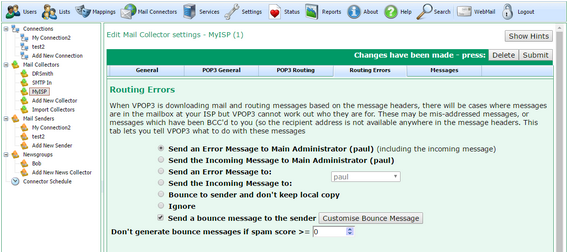
To get to this page, to to Mail Connectors → (choose Mail Collector) → Routing Errors. This tab is only available if the Mail Collection Method on the General tab is set to Download from a POP3 Server and the routing method set on the POP3 Routing tab is set to Route by parsing message headers.
This page tells VPOP3 what to do if it can't find any valid recipients after parsing the message headers to find the recipients.
Routing errors can occur if your ISP has a catch-all POP3 mailbox and someone sends a message to a non-existent user, or if someone sends a message to you using a BCC, which means that the recipient email address will not be in the headers anywhere that VPOP3 can find it.
The main section is a choice of 6 options for what to do if there is an incoming message with no recognised recipients:
•Send an error message to Main Administrator (<admin name>) - this option makes VPOP3 send an error message to the Main Administrator indicating why the message could not be delivered automatically. The error message will contain the original incoming message as an attachment.
•Send the incoming message to Main Administrator - this option makes VPOP3 send the incoming message to the Main Administrator as if it was originally intended for them. This can look 'neater' than the above option because there isn't the extra error text, but it can make it harder to work out why the message couldn't be delivered properly, or can cause confusion because the administrator may think the message was actually addressed to them.
•Send an Error Message to - this is the same as the first option above, but the recipient is specified explicitly.
•Send the incoming message to - this is the same as the second option above, but the recipient is specified explicitly.
•Bounce to sender and don't keep local copy - a bounce message is sent to the message sender and the message is deleted. The bounce message can be customised using the Customise Bounce Message button below.
•Ignore - the message is simply discarded silently.
The Send a bounce message to the sender option will do the above option and also send a message to the original sender to tell them that the message could not be delivered. The bounce message can be customised using the Customise Bounce Message button.
Note that sending a bounce message in this way can cause something called backscatter. This happens because spammers can forge sender email addresses quite easily, so when you send a bounce message back, that bounce message is not going to the spammer but to some innocent person whose email address was forged by the spammer. Thus, it is generally considered bad manners to do this. Bounce messages sent as part of an incoming SMTP transaction are fine because those shouldn't cause backscatter because they work totally differently.
The Don't generate bounce messages if spam score >= ... - this tells VPOP3 not to generate a bounce message if the spam score is greater than the specified amount. This can help reduce the problem of backscatter.

